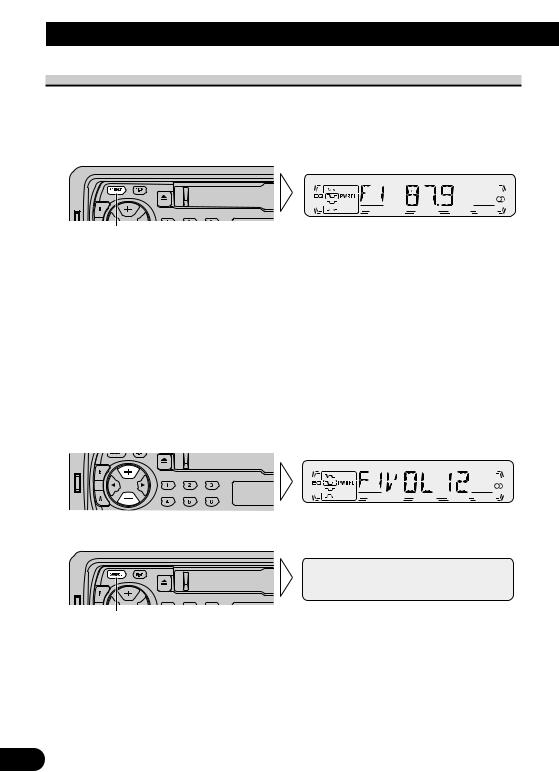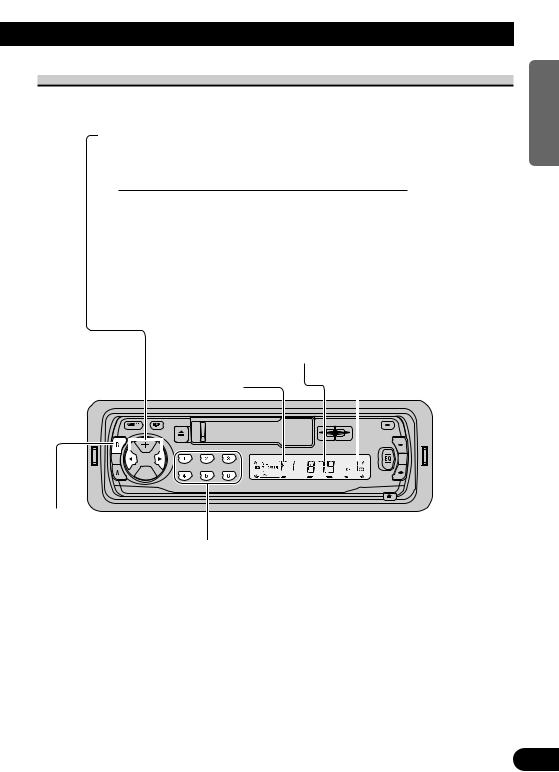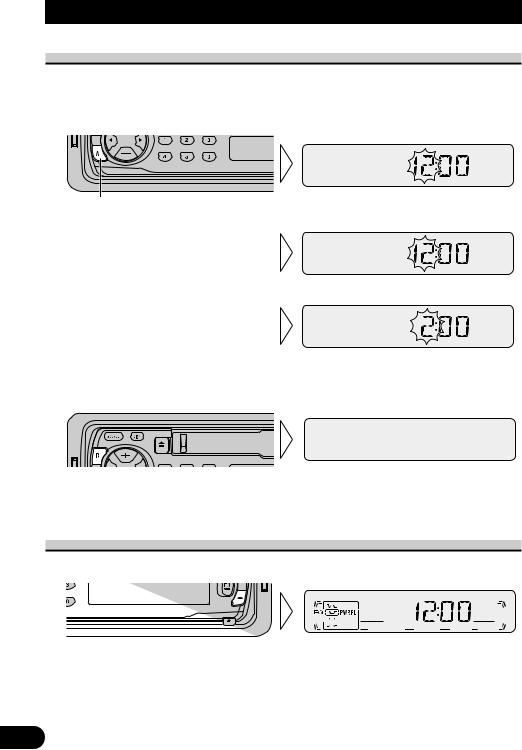PIONEER KEH-P1010, KEH-p1015 Service Manual

Multi-CD control High power cassette player with FM/AM tuner
Syntoniseur FM/AM et lecteur de cassette, “Puissance élevée”, avec contrôleur pour lecteur de CD à chargeur
Operation Manual
KEH-P1010
Mode d’emploi
FRANÇAIS ESPAÑOL FRANÇAIS ENGLISH
NEDERLANDS ITALIANO

Contents |
|
Dear Customer ............................................ |
2 |
Key Finder .................................................... |
3 |
- Head Unit |
|
Before Using This Product ...................... |
4 |
About This Product .......................................... |
4 |
About This Manual ............................................ |
4 |
Important .......................................................... |
4 |
Precaution .......................................................... |
4 |
After-sales Service for Pioneer Products .......... |
4 |
Basic Operation ........................................ |
5 |
To Listen to Music ............................................ |
5 |
Basic Operation of Tuner .................................. |
6 |
- Manual and Seek Tuning |
|
- Band |
|
- Preset Tuning |
|
Basic Operation of Cassette Player .................. |
7 |
- Fast Forward/Rewind |
|
- Cassette Loading Slot |
|
- Direction Change |
|
- Eject |
|
Basic Operation of Multi-CD Player ................ |
8 |
-Track Search and Fast Forward/Reverse
-Switching the Display
-Disc Number Search
(for 6-Disc, 12-Disc types)
Tuner Operation ........................................ |
9 |
-Local Seek Tuning
-Best Stations Memory (BSM)
Using the Cassette Player ...................... |
10 |
- Radio Intercept |
|
Using Multi-CD Players .......................... |
11 |
- Repeat Play |
|
- Pause |
|
Audio Adjustment .................................... |
12 |
Selecting the Equalizer Curve ........................ |
12 |
Entering the Audio Menu ................................ |
12 |
Audio Menu Functions .................................... |
13 |
-Balance Adjustment (FADER)
-Equalizer Curve Adjustment (EQ)
-Loudness Adjustment (LOUD)
-Front Image Enhancer Function (FIE)
-Source Level Adjustment (SLA)
Detaching and Replacing |
|
the Front Panel .................................. |
16 |
Theft Protection .............................................. |
16 |
-Detaching the Front Panel
-Replacing the Front Panel
Other Functions ........................................ |
17 |
Setting the Time .............................................. |
17 |
Displaying the Time ........................................ |
17 |
Cassette Player and Care ...................... |
18 |
Precaution ........................................................ |
18 |
-About the Cassette Player
-About Cassette Tapes
Cleaning the Head .......................................... |
18 |
Specifications .......................................... |
19 |
1

Selecting fine audio equipment such as the unit you’ve just purchased is only the start of your musical enjoyment. Now it’s time to consider how you can maximize the fun and excitement your equipment offers. This manufacturer and the Electronic Industries Association’s Consumer Electronics Group want you to get the most out of your equipment by playing it at a safe level. One that lets the sound come through loud and clear without annoying blaring or distortion—and, most importantly, without affecting your sensitive hearing.
Sound can be deceiving. Over time your hearing “comfort level” adapts to higher volumes of sound. So what sounds “normal” can actually be loud and harmful to your hearing. Guard against this by setting your equipment at a safe level BEFORE your hearing adapts.
To establish a safe level:
•Start your volume control at a low setting.
•Slowly increase the sound until you can hear it comfortably and clearly, and without distortion.
Once you have established a comfortable sound level:
• Set the dial and leave it there.
Taking a minute to do this now will help to prevent hearing damage or loss in the future. After all, we want you listening for a lifetime.
We Want You Listening For A Lifetime
Used wisely, your new sound equipment will provide a lifetime of fun and enjoyment. Since hearing damage from loud noise is often undetectable until it is too late, this manufacturer and the Electronic Industries Association’s Consumer Electronics Group recommend you avoid prolonged exposure to excessive noise. This list of sound levels is included for your protection.
Decibel
Level Example
30 Quiet library, soft whispers
40 Living room, refrigerator, bedroom away from traffic
50 Light traffic, normal conversation, quiet office
60 Air conditioner at 20 feet, sewing machine
70 Vacuum cleaner, hair dryer, noisy restaurant
80 Average city traffic, garbage disposals, alarm clock at two feet.
THE FOLLOWING NOISES CAN BE DANGEROUS UNDER CONSTANT EXPOSURE
90 Subway, motorcycle, truck traffic, lawn mower
100 Garbage truck, chain saw, pneumatic drill
120 Rock band concert in front of speakers, thunderclap
140 Gunshot blast, jet plane
180 Rocket launching pad
Information courtesy of the Deafness Research Foundation.
NEDERLANDS ITALIANO FRANÇAIS DEUTSCH ESPAÑOL ENGLISH
2

Key Finder
Head Unit
SOURCE button
BAND button
DISPLAY button
EJECT button |
1/¡ buttons |
|
|
Cassette door |
LOCAL/BSM button |
LOUD button |
AUDIO button |
2/3 buttons |
EQ button
Buttons 1–6
CLOCK button Detach button
+/– buttons
3

BeforeK y FinderUsing This Product
About This Product
The tuner frequencies on this product are allocated for use in North America. Use in other areas may result in improper reception.
About This Manual
This product features a number of sophisticated functions ensuring superior reception and operation. All are designed for the easiest possible use, but many are not self-explanatory. This operation manual is intended to help you benefit fully from their potential and to maximize your listening enjoyment.
We recommend that you familiarize yourself with the functions and their operation by reading through the manual before you begin using this product. It is especially important that you read and observe the “Precaution” on this page and in other sections.
Important
The serial number of this device is located on the bottom of this product. For your own security and convenience, be sure to record this number on the enclosed warranty card.
Precaution
•Keep this manual handy as a reference for operating procedures and precautions.
•Always keep the volume low enough for outside sounds to be audible.
•Protect the product from moisture.
•If the battery is disconnected, the preset memory will be erased and must be reprogrammed.
After-sales Service for Pioneer Products
Please contact the dealer or distributor from where you purchased the product for its aftersales service (including warranty conditions) or any other information. In case the necessary information is not available, please contact the companies listed below:
Please do not ship your product to the companies at the addresses listed below for repair without advance contact.
7U.S.A. |
7CANADA |
Pioneer Electronics Service, Inc. |
Pioneer Electronics of Canada, Inc. |
CUSTOMER SERVICE |
CUSTOMER SERVICE |
DEPARTMENT |
DEPARTMENT |
P.O. Box 1760 |
300 Allstate Parkway |
Long Beach, CA 90801 |
Markham, Ontario L3R OP2 |
800-421-1404 |
(905) 479-4411 |
|
1-877-283-5901 |
For warranty information please see the Limited Warranty sheet included with your product.
NEDERLANDS ITALIANO FRANÇAIS DEUTSCH ESPAÑOL ENGLISH
4

Basic Operation
To Listen to Music
The following explains the initial operations required before you can listen to music.
Note:
• Loading a cassette in this product. (Refer to page 7.)
1.Select the desired source (e.g. Tuner).
Each press changes the Source ...
Each press of the SOURCE button selects the desired source in the following order: Tuner = Cassette player = Multi-CD player = External Unit
Note:
•External Unit refers to a Pioneer product (such as one available in the future) that, although incompatible as a source, enables control of basic functions by this product. Only one External Unit can be controlled by this product.
•In the following cases, the sound source will not change:
*When a product corresponding to each source is not connected to this product.
*When no tape is set in this product.
*When no magazine is set in the Multi-CD player.
•When this product’s blue/white lead is connected to the car’s Auto-antenna relay control terminal, the car’s Auto-antenna extends when this product’s source is switched ON. To retract the antenna, switch the source OFF.
2.Raise or lower the volume.
3.Turn the source OFF.
Hold for 1 second
5

Basic Operation of Tuner
Manual and Seek Tuning
•You can select the tuning method by changing the length of time you press the 2/3 button.
Manual Tuning (step by step) |
0.5 seconds or less |
Seek Tuning |
0.5 seconds or more |
|
|
Note:
•If you continue pressing the button for longer than 0.5 seconds, you can skip broadcasting stations. Seek Tuning starts as soon as you release the button.
•Stereo indicator “ ” lights when a stereo station is selected.
Frequency Indicator
|
|
|
|
Band Indicator |
|
|
Preset Number Indicator |
||
|
|
|
|
|
|
|
|
|
|
|
|
|
|
|
|
|
|
|
|
|
|
|
|
|
|
|
|
|
|
|
|
|
|
|
|
|
|
|
|
|
|
|
|
|
|
|
|
|
|
|
|
|
|
|
|
|
|
|
|
Band
F1 (FM1) = F2 (FM2) |
Preset Tuning |
|
|
= F3 (FM3) = AM |
|
||
|
• You can memorize broadcast stations in but- |
||
|
|
tons 1 through 6 for easy, one-touch station |
|
|
|
recall. |
|
|
|
|
|
|
|
Preset station recall |
2 seconds or less |
|
|
|
|
|
|
Broadcast station preset memory |
2 seconds or more |
|
|
|
|
Note:
•Up to 18 FM stations (6 each in F1 (FM1), F2 (FM2) and F3 (FM3)) and 6 AM stations can be stored in memory.
NEDERLANDS ITALIANO FRANÇAIS DEUTSCH ESPAÑOL ENGLISH
6

Basic Operation
Basic Operation of Cassette Player
Fast Forward/Rewind
•To select Fast Forward, press the button for the same direction as the direction indicator.
•To select Rewind, press the button for the opposite direction as the direction indicator.
Note:
•To release Fast Forward/Rewind, lightly press the 1 or ¡ button located on the opposite side of the one you pressed to Fast Forward or Rewind.
Direction Change
• To change the
Cassette Loading Slot |
direction, press |
|
the 1 and ¡ |
||
|
||
|
buttons at the |
|
|
same time. |
Eject |
Direction Indicator |
7

Basic Operation of Multi-CD Player
This product can control a Multi-CD player (sold separately).
Track Search and Fast Forward/Reverse
•You can select between Track Search or Fast Forward/Reverse by pressing the 2/3 button for a different length of time.
Track Search |
0.5 seconds or less |
Fast Forward/Reverse |
Continue pressing |
|
|
Switching the Display
Each press of the DISPLAY button changes the display in the following order:
Playback mode (Play Time) = Disc and Track Number
Play Time Indicator
Disc Number Search (for 6-Disc, 12-Disc types)
•You can select discs directly with the 1 to 6 buttons. Just press the number corresponding to the disc you want to listen to.
Note:
•When a 12-Disc Multi-CD Player is connected and you want to select disc 7 to 12, press the 1 to 6 buttons for 2 seconds or longer.
Note:
•The Multi-CD player may perform a preparatory operation, such as verifying the presence of a disc or reading disc information, when the power is turned ON or a new disc is selected for playback. “READY” is displayed.
•If the Multi-CD player cannot operate properly, an error message such as “ERR14” is displayed. Refer to the Multi-CD player owner’s manual.
•If there are no discs in the Multi-CD player magazine, “NODSC” is displayed.
NEDERLANDS ITALIANO FRANÇAIS DEUTSCH ESPAÑOL ENGLISH
• You can not operate the 50-Disc Type Multi-CD Player with this product. |
8 |
|

Tuner Operation
Local Seek Tuning
This function selects only stations with especially strong signals.
• Switch the Local ON/OFF
with the LOCAL/BSM button.
“LOC”
Best Stations Memory (BSM)
The BSM function stores stations in memory automatically.
• Press the LOCAL/BSM button for 2 seconds to switch BSM ON.
The stations with the strongest signals will be stored under buttons 1–6 and in order of their signal strength.
•To cancel the process, press the LOCAL/BSM button before memorization is complete.
9

Using the Cassette Player
Radio Intercept
This function allows you to listen to the radio during tape fast-forwarding/rewinding.
• Switch the Radio Intercept
ON/OFF with the button 6.
“RI”
NEDERLANDS ITALIANO FRANÇAIS DEUTSCH ESPAÑOL ENGLISH
10

Using Multi-CD Players
Repeat Play
There are three repeat play ranges: One-track Repeat, Disc Repeat and Multi-CD player Repeat. Default repeat play range is Multi-CD player Repeat.
• Select the desired repeat play range pressing the LOCAL/BSM button for 2 seconds.
Multi-CD player Repeat = Onetrack Repeat = Disc Repeat
Play range |
Display |
Multi-CD player Repeat |
MCD |
|
|
One-track Repeat |
TRK |
|
|
Disc Repeat |
DSC |
|
|
Note:
•If you select other discs during the repeat play, the repeat play range changes to Multi-CD player Repeat.
•If you perform Track Search or Fast Forward/Reverse during One-track Repeat, the repeat play range changes to Disc Repeat.
Pause
Pause pauses the currently playing track.
• Switch the Pause play ON/OFF with the LOCAL/BSM button.
11

Audio Adjustment
Selecting the Equalizer Curve
You can switch between Equalizer curves.
• Press the EQ button to select the desired Equalizer curve.
Equalizer curve
PWRFL (powerful) = NTRL (natural) = VOCAL (vocal) =  (custom) = NOTHING (flat) = S.BASS (super bass)
(custom) = NOTHING (flat) = S.BASS (super bass)
Note:
•“  (custom)” stores an equalizer curve you have made adjustments to. (Refer to “Equalizer Curve Adjustment” on page 14.)
(custom)” stores an equalizer curve you have made adjustments to. (Refer to “Equalizer Curve Adjustment” on page 14.)
Entering the Audio Menu
With this Menu, you can adjust the sound quality.
Note:
•After entering the Audio Menu, if you do not perform an operation within about 30 seconds, the Audio Menu is automatically canceled.
1.Select the desired mode in the Audio Menu.
Each press changes the Mode ...
2.Operate a mode.
3.Cancel the Audio Menu.
NEDERLANDS ITALIANO FRANÇAIS DEUTSCH ESPAÑOL ENGLISH
12

Audio Adjustment
Audio Menu Functions
The Audio Menu features the following functions.
Balance Adjustment (FADER)
This function allows you to select a Fader/Balance setting that provides ideal listening conditions in all occupied seats.
1.Press the AUDIO button and select the Fader/Balance mode (FADER) in the Audio Menu.
2.Adjust front/rear speaker bal-
ance with the +/– buttons.
“F15” – “R15” is displayed as it moves from front to rear.
3. Adjust left/right speaker balance with the 2/3 buttons.
“BAL:L9” – “BAL:R9” is displayed as it moves from left to right.
Note:
• “0” is the proper setting when 2 speakers are in use.
13

Equalizer Curve Adjustment (EQ)
You can adjust the currently selected equalizer curve settings as desired. Adjusted equalizer curve settings are memorized in “  (custom)”.
(custom)”.
1.Press the AUDIO button and select the Equalizer mode (EQ) in the Audio Menu.
2.Select the band you want to
adjust with the 2/3 buttons.
L (low) += M (mid) += H (high)
3. Boost or attenuate the selected band with the +/– buttons.
The display shows “+6” – “–6”.
“  ”
”
Note:
•If you make adjustments when a curve other than “custom” is selected, the newly adjusted curve
will replace the previous adjusted curve. Then a new curve with “  ” appears on the display while selecting the equalizer curve. (Refer to page 13.)
” appears on the display while selecting the equalizer curve. (Refer to page 13.)
Loudness Adjustment (LOUD)
The Loudness function compensates for deficiencies in the low and high sound ranges at low volume. You can select a desired Loudness level.
1.Press the AUDIO button and select the Loudness mode (LOUD) in the Audio Menu.
2.Switch the Loudness function
ON/OFF with the +/– buttons.
“  LOUD”
LOUD”
3. Select the desired level with the 2/3 buttons.
LOW (low) += MID (mid) += HI (high)
Note:
• You can also switch the Loudness function ON/OFF by pressing the LOUD button.
NEDERLANDS ITALIANO FRANÇAIS DEUTSCH ESPAÑOL ENGLISH
14

Audio Adjustment
Front Image Enhancer Function (FIE)
The F.I.E. (Front Image Enhancer) function is a simple method of enhancing front imaging by cutting midand high-range frequency output from the rear speakers, limiting their output to low-range frequencies. You can select the frequency you want to cut.
Precaution:
•When the F.I.E. function is deactivated, the rear speakers output sound of all frequencies, not just bass sounds. Reduce the volume before disengaging F.I.E. to prevent a sudden increase in volume.
1.Press the AUDIO button and select the F.I.E. mode (FIE) in the Audio Menu.
2.Switch the F.I.E. function
ON/OFF with the +/– buttons.
“FIE”
3. Select the desired frequency with the 2/3 buttons.
100 += 160 += 250 (Hz)
Note:
•After switching the F.I.E. function ON, select the Fader/Balance mode in the Audio Menu, and adjust front and rear speaker volume levels until they are balanced.
•Switch the F.I.E. function OFF when using a 2-speaker system.
Source Level Adjustment (SLA)
The SLA (Source Level Adjustment) function prevents radical leaps in volume level when switching between sources. Settings are based on the FM volume level, which remains unchanged.
1.Compare the FM volume with the volume of the other source (e.g. Cassette player).
2.Press the AUDIO button and select the SLA mode (SLA) in the Audio Menu.
3.Increase or decrease the level
with the +/– buttons.
The display shows “+4” – “–4”.
Note:
•Since the FM volume is the control, SLA is not possible in the FM modes.
•The AM volume level, which is different from the FM base setting volume level, can be adjusted similar to sources other than tuner.
15

Detaching and Replacing the Front Panel
Theft Protection
The front panel of the head unit is detachable to discourage theft.
Detaching the Front Panel
1. Eject the front panel.
2.To remove the front panel, pull its right-hand side toward you.
Take care not to grip it tightly or drop it.
Replacing the Front Panel
•Replace the front panel by clipping it into place.
Precaution:
•Never use force or grip the display tightly when removing or replacing the front panel.
•Avoid subjecting the front panel to excessive shocks.
•Keep the front panel out of direct sunlight and high temperatures.
NEDERLANDS ITALIANO FRANÇAIS DEUTSCH ESPAÑOL ENGLISH
16

Other Functions
Setting the Time
This is the mode for setting the time on this product’s clock display.
1.Switch the source OFF.
2.Enter the Time setting mode.
Hold for 2 seconds
3. Select “Hour” or “Minute” with the 2/3 buttons.
4. Set as desired with the +/– buttons.
As soon as you switch to “Minute”, the seconds start counting from 00.
5. Cancel the Time setting mode.
Note:
• Holding down the AUDIO button for 2 seconds also cancels the Time setting mode.
Displaying the Time
•To turn the time display ON with the source ON.
The time display disappears temporarily when you perform another operation, but the time indication returns to the display after 25 seconds.
17

Cassette Player and Care
Precaution
About the Cassette Player
•A loose or warped label on a cassette tape may interfere with the eject mechanism of the unit or cause the cassette to become jammed in the unit. Avoid using such tapes or remove such labels from the cassette before attempting use.
•Be sure to eject the tape when the vehicle’s ignition is turned OFF. Leaving the tape in the unit can deform the pinch roller causing wow and flutter during tape playback.
About Cassette Tapes
•Loose tapes should be rewound with the aid of a pencil and unevenly wound tapes rewound with the use of the fast forward function.
•Do not use tapes longer than C-90 type (90 min.) cassettes. Longer tapes can interfere with tape transport.
•Storing cassettes in areas directly exposed to sunlight or high temperatures can distort them and subsequently interfere with tape transport.
RECOMMENDED
NOT
•Store unused tapes in a tape case where there is no danger of them becoming loose or being exposed to dust.
Cleaning the Head
If the head becomes dirty, the sound quality will deteriorate and there will be sound dropouts and other imperfections in performance. In this case, the head must be cleaned.
NEDERLANDS ITALIANO FRANÇAIS DEUTSCH ESPAÑOL ENGLISH
18

Specifications
General
Power source .......... |
14.4 V DC (10.8 – 15.1 V allowable) |
||
Grounding system ........................................ |
|
Negative type |
|
Max. current consumption ........................................ |
|
8.5 A |
|
Dimensions |
178 (W) × |
50 (H) × 155 (D) mm |
|
(DIN) (chassis) |
|||
|
[7 (W) × |
2 (H) × 6-1/8 (D) in] |
|
(nose) ............ |
188 (W) × |
58 (H) × |
19 (D) mm |
|
[7-3/8 (W) × 2-1/4 (H) × |
3/4 (D) in] |
|
(D) (chassis) |
...... 178 (W) × |
50 (H) × 160 (D) mm |
|
|
[7 (W) × |
2 (H) × 6-1/4 (D) in] |
|
(nose) ............ |
170 (W) × |
48 (H) × |
14 (D) mm |
|
[6-3/4 (W) × 1-7/8 (H) × |
1/2 (D) in] |
|
Weight ........................................................ |
|
1.2 kg (2.6 lbs) |
|
FM tuner
Frequency range .................................... |
87.9 – 107.9 MHz |
Usable sensitivity .................................................... |
11 dBf |
(1.1 µ V/75 Ω , mono, S/N: 30 dB) |
|
50 dB quieting sensitivity |
........................................ 17 dBf |
|
(2.2 µ V/75 Ω , mono) |
Signal-to-noise ratio ...................... |
58 dB (IHF-A network) |
Distortion ........................ |
0.66% (at 65 dBf, 1 kHz, stereo) |
Frequency response ...................... |
30 – 15,000 Hz (±3 dB) |
Stereo separation .......................... |
24 dB (at 65 dBf, 1 kHz) |
Selectivity .................................................... |
71 dB (2ACA) |
Three-signal intermodulation |
|
(desired signal level) |
........................................ 47 dBf |
(two undesired signal level: 100 dBf)
Amplifier
Continuous power output is 20 W per channel min. into 4 ohms, both channels driven 50 to 15,000 Hz with no more
than 5% THD. |
|
|
45 W × 4 |
Maximum power output ...................................... |
|||
Load impedance |
.......................... |
4 Ω |
(4 – 8 Ω allowable) |
Preout maximum output level/ |
2.2 V/1 kΩ |
||
output impedance |
.................................... |
||
Equalizer (3 band equalizer) |
|
||
(Low) .............................................................. |
|
|
±12 dB |
(Mid) .............................................................. |
|
|
±12 dB |
(High) ............................................................ |
|
|
±12 dB |
Loudness contour |
|
|
|
(Low) .................. |
|
+3.5 dB (100 Hz), +3 dB (10 kHz) |
|
(Mid) ................ |
+10 dB (100 Hz), +6.5 dB (10 kHz) |
||
(High) ................ |
|
+11 dB (100 Hz), +11 dB (10 kHz) |
|
|
|
|
(volume: –30 dB) |
AM tuner
Frequency range ...................... |
530 – 1,710 kHz (10 kHz) |
Usable sensitivity .............................. |
20 µ V (S/N: 20 dB) |
Selectivity ................................................ |
50 dB (±10 kHz) |
Cassette player
Tape ........................ |
Compact cassette tape (C-30 – C-90) |
|
Tape speed ........................................................ |
|
4.8 cm/sec. |
Fast forward/rewinding time .... |
Approx. 100 sec. for C-60 |
|
Wow & flutter .......................................... |
|
0.13% (WRMS) |
Frequency response ...................... |
|
30 – 16,000 Hz (±3 dB) |
Stereo separation ...................................................... |
|
45 dB |
Signal-to-noise ratio...................... |
|
41 dB (IHF-A network) |
Note:
• Specifications and the design are subject to possible modification without notice due to improvements.
19
